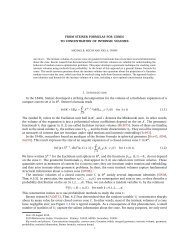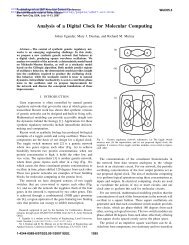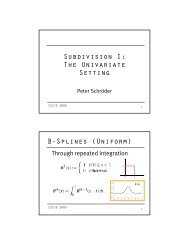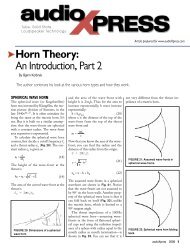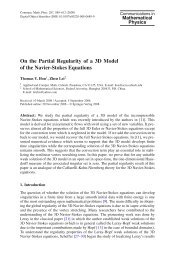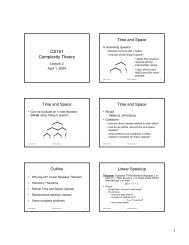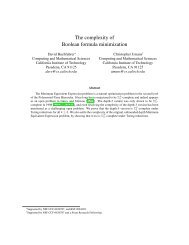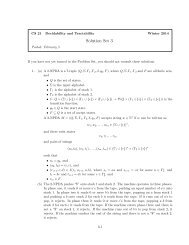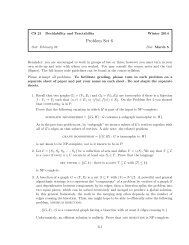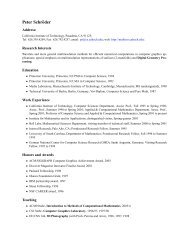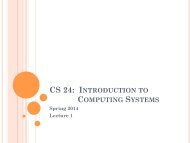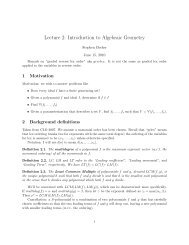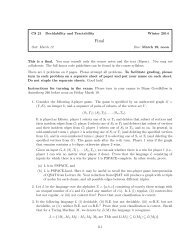Removing the Stiffness from Interfacial Flows with Surface Tension
Removing the Stiffness from Interfacial Flows with Surface Tension
Removing the Stiffness from Interfacial Flows with Surface Tension
Create successful ePaper yourself
Turn your PDF publications into a flip-book with our unique Google optimized e-Paper software.
330 HOU, LOWENGRUB, AND SHELLEYspectrum had risen to 10 -8 (<strong>from</strong> 10-16). The N= 8192computation was stopped at t = 45, even though its highmodes had risen to only 10-11. We note that <strong>the</strong> computedarea of <strong>the</strong> bubble at t = 45 still agrees to six digits <strong>with</strong> itsexact value.The calculation to t = 25.0 took about 9 days on anIBM R6000 workstation. Had <strong>the</strong>re been no accompayingintegral equation to solve, it would have taken but a fewhours. The best approach to reducing this time appears tobe finding better preconditioners for <strong>the</strong> iteration. Previouscalculations of similar flows have been performed [ 15, 16].The time step here is 103 times larger than that used by Daiand Shelley [ 16 ] in computations of a similar flow using anexplicit method <strong>with</strong> a lesser number of points, and <strong>the</strong>interface here has developed far more structure. Fur<strong>the</strong>r, nosymmetries have been imposed. Again, fur<strong>the</strong>r details willappear elsewhere.7.2. Numerical Results: Inertial Vortex SheetsIn <strong>the</strong>se last two subsections, we examine <strong>the</strong> long-timeevolution of inertial vortex sheets <strong>with</strong> surface tension, bothin a homogeneous fluid and in a fluid <strong>with</strong> slight densitystratification. Leaving aside issues such as dimensionalityand viscous effects, <strong>the</strong> first case is not a completely artificialsituation. Two immiscible fluids can be density matched andstill produce a surface tension. Fur<strong>the</strong>r, in <strong>the</strong> absence ofsurface tension, <strong>the</strong> singularities of a vortex sheet embedded<strong>with</strong>in a homogeneous fluid give <strong>the</strong> basic form of <strong>the</strong>singularities observed on an interface evolving by <strong>the</strong>Rayleigh-Taylor instability [ 5 ]. Our results in <strong>the</strong> last subsectionsuggest that this still holds true <strong>with</strong> <strong>the</strong> addition ofsurface tension.Computationally, such problems have also been consideredby Pullin [ 38 ], by Rangel and Sirignano [ 39], byBaker and Nachbin [7], and by Beale et al. [ 10, 12]. Pullinused a method based on cubic splines and observed apersistent numerical instability that was only slightlyameliorated by additional smoothing of <strong>the</strong> interface position.His calculations are restricted to short times. Rangel etaL used a similar method, combined <strong>with</strong> a remeshing, usinglinear interpolation of <strong>the</strong> interface positions and sheetstrength, at every time step. This is strongly smoothing.Indeed, <strong>the</strong>y calculate <strong>the</strong> smooth roll-up of <strong>the</strong> sheet, even<strong>with</strong>out surface tension, for which it is known that asingularity interrupts <strong>the</strong> motion well before roll-up occurs[33, 31, 44]. Baker and Nachbin and Beale et al. investigate<strong>the</strong> stability of spatial discretizations. In <strong>the</strong>se works, <strong>the</strong>issue of stiffness is not addressed, and <strong>the</strong> calculations areagain restricted to short times.7.2.1. Numerical <strong>Stiffness</strong>In this section, <strong>the</strong> stability constraints are compared for<strong>the</strong> second-order linear propagator, Crank-Nicholson/leapfrog, and explicit second-order Adams-Bashforthmethods for small scale decomposition of <strong>the</strong> 0 - L formulationof inertial vortex sheets, Eqs. (55) and (56). For <strong>the</strong>explicit scheme, <strong>the</strong> Adams-Bashforth discretization is usedin all three equations. The initial condition isx(~, 0) = ~ + 0.01 sin 2zt~, y(ct, 0) -- -0.01 sin 2~,7(~, 0)= 1.0.(95)This initial data was used by Krasny [31] in <strong>the</strong> absence ofsurface tension. In that case, a curvature singularity forms att ~ 0.375. The calculations here have S = 0.005, which gives16 linearly growing modes in <strong>the</strong> period.Figure 10 shows plots of log10 IP(k)F for <strong>the</strong> threemethods <strong>with</strong> N = 64 and N= 256 at t = 0.12. This is a factorof 4 increase in N, and so <strong>the</strong> near equilibrium constraintAt < Ch 3/2 requires a factor of 8 decrease in time step. Theresults <strong>from</strong> <strong>the</strong> Crank-Nicholson/leapfrog scheme aregiven in <strong>the</strong> first column. The time step At = 0.01 is used forboth resolutions and this scheme is clearly stable. As <strong>the</strong>reis little spatial complexity (i.e., no large aliasing errors),filtering has not been used. The results <strong>from</strong> <strong>the</strong> explicitAdams-Bashforth scheme are given in <strong>the</strong> middle column.The +-curves correspond to At = 3.1 x 10-4 for N = 64 andAt = 3.9 x 10-5 for N= 256. This is again <strong>the</strong> factor of 8 aspredicted by <strong>the</strong> stability constraint. The solid lines showthat <strong>the</strong> time step constraint is violated <strong>with</strong> At = 1.2 x 10 -3<strong>with</strong> N= 64 and At = 7.8 x 10-5 <strong>with</strong> N = 256. In <strong>the</strong> thirdcolumn of <strong>the</strong> figure <strong>the</strong> results are <strong>from</strong> <strong>the</strong> integratingl°glol$'(k)!l 0C-N, (a)° i , t=.12, N=64I-15 ~I]- dt=.01o-5-IO-15Expficit A-B. (b)t=. 12, N=64- dt=l.2d-3+ dt~3.1d-4Lin. Prop., (c)-2c-20 I50 1000 50 100kkk-2C-2-2050 100 50 I00 0 50 100k k k(d)(t=.12, N=256(g)t=.12, N=256(Dt=.12, N=256-5 - dt=.01- dt=7.Sd-5- dt=9.Sd-6-5+ dt=3.9d-5logaol~'(k)l-K-15-10:-10-15-10-15t=.12, N=64- dt=6.3d-4+ dt=l.6d-4FIG. 10. Inertial vortex sheet numerical stiffness: a comparison oflog10 I~(k)l vs k <strong>with</strong> S= 0.005 at t = 0.12: (a) Crank-Nicholson, N= 64,At = 0.01; (b) explicit second-order Adams-Bashforth, N= 64, At =1.2 × 10-3, 3.1 x 10-4; (c) linear propagator, N= 64, At = 6.3 x 10-4,1.6x 10-4; (d) C-N, N=256, At=0.01; (e) explicit A-B, N=256, At=7.8 x 10-5, 3.9 × 10 -5; (f) lin. prop., N= 256, At, At = 9.8 x 10-6.



